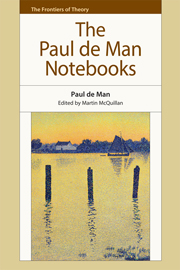Book contents
- Frontmatter
- Contents
- Series Editor's Preface
- Acknowledgements
- Dedication
- Introduction: ‘The Unimaginable Touch of Time’: The Public and Private in the Notebooks of Paul de Man
- PART I Texts
- PART II Translations
- PART III Teaching
- PART IV Research
- 27 The Unimaginable Touch of Time: Proposed Table of Contents
- 28 Modernism in Literature: Background and Essay Selection
- 29 Modernism in Literature: Revised Table of Contents
- 30 The Portable Rousseau: Table of Contents
- 31 The Portable Rousseau: Principle of Selection
- 32 Outline for a Monograph on Nietzsche
- 33 From Nietzsche to Rousseau
- 34 Allegories of Reading: Figural Language in Rousseau, Nietzsche, Rilke, and Proust
- 35 Aesthetics, Rhetoric, Ideology
- 36 11/3/82
- Appendix. The Notebooks of Paul de Man 1963–83
- Bibliography
- Index of Names
34 - Allegories of Reading: Figural Language in Rousseau, Nietzsche, Rilke, and Proust
from PART IV - Research
Published online by Cambridge University Press: 05 December 2014
- Frontmatter
- Contents
- Series Editor's Preface
- Acknowledgements
- Dedication
- Introduction: ‘The Unimaginable Touch of Time’: The Public and Private in the Notebooks of Paul de Man
- PART I Texts
- PART II Translations
- PART III Teaching
- PART IV Research
- 27 The Unimaginable Touch of Time: Proposed Table of Contents
- 28 Modernism in Literature: Background and Essay Selection
- 29 Modernism in Literature: Revised Table of Contents
- 30 The Portable Rousseau: Table of Contents
- 31 The Portable Rousseau: Principle of Selection
- 32 Outline for a Monograph on Nietzsche
- 33 From Nietzsche to Rousseau
- 34 Allegories of Reading: Figural Language in Rousseau, Nietzsche, Rilke, and Proust
- 35 Aesthetics, Rhetoric, Ideology
- 36 11/3/82
- Appendix. The Notebooks of Paul de Man 1963–83
- Bibliography
- Index of Names
Summary
9. A summary of the book, with highlights and pertinent points which might guide us in the preparation of advertising, publicity, jacket, and catalog copy. Use reverse side of sheet if more space is needed. We would appreciate having about 300 words. Your own abstract of the book is essential as a guide in our advertising and promotion.
The book offers a reading of a group of authors and texts dating from 1750 to the early twentieth century and used as examples to illustrate a mode of reading and of interpretation. The most extensive reading offered is that of Rousseau, who is considered at length in an overview that includes the major fictional, political and confessional writings. In the case of Proust and of Rilke, the corpus is much less extended, although it claims to be representative of structures that recur in the work as a whole. No such claim is made for Nietzsche, where the reading of The Birth of Tragedy and of some sections mostly taken from the posthumous works is preparatory to an understanding of larger works such as Zarathustra or The Genealogy of Morals. On this level, the book aims to be a contribution to the understanding of four important figures, spanning several genres and a historical period from pre-romanticism to the present, addressed to readers and interpreters of this period.
It also has a wider theoretical aim. The readings start from unresolved difficulties in the critical traditions which these authors have engendered and return to the places in the texts where those difficulties are most clearly apparent or most incisively reflected upon. The close reading of these passages leads to the elaboration of a more general model of textual understanding.
- Type
- Chapter
- Information
- The Paul de Man Notebooks , pp. 303 - 304Publisher: Edinburgh University PressPrint publication year: 2014

